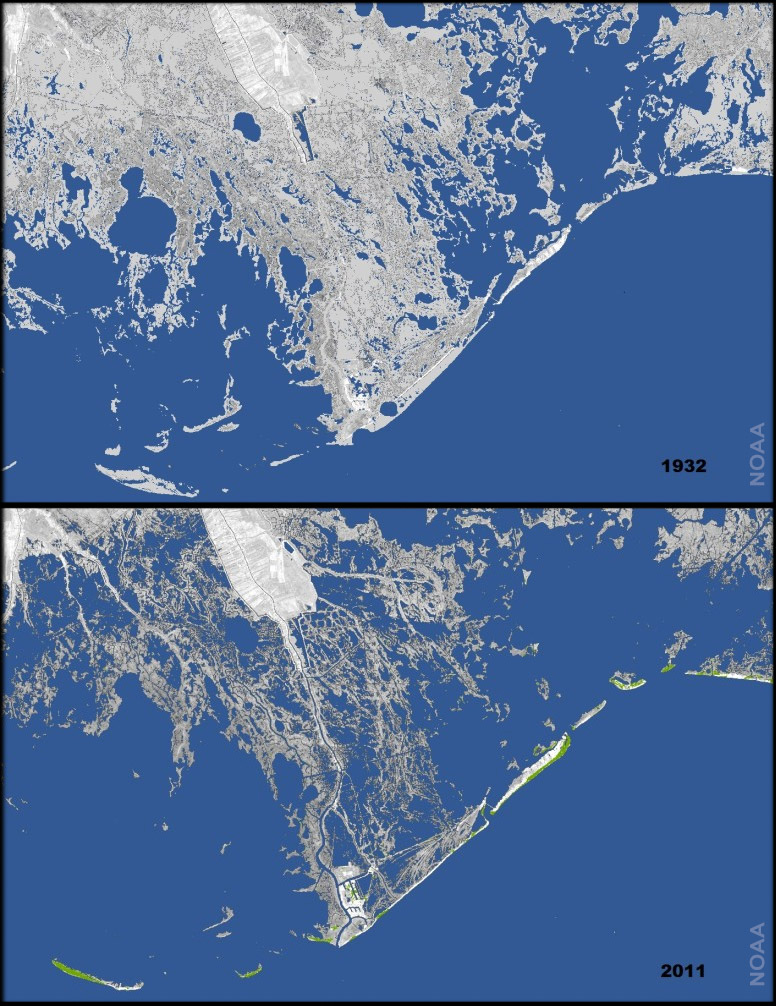Southeast Louisiana is in the news once again—not for a hurricane or a flood this time, but for efforts to protect communities dealing with the blows of these disasters, along with the impacts of climate change.
On Tuesday, The New York Times profiled the community of Isle de Jean Charles, the island home of the Biloxi-Chitimacha-Choctaw, located where the southern edge of Terrebonne Parish meets the Gulf of Mexico. Families on the island, who have lived and worked on the water for generations, are planning to relocate further north, to escape the rising seas and sinking land. After years of trying to deal with near constant flooding, while still keeping their tribal community together, new hope came recently, in the form of a $48 million grant from the US Department of Housing and Urban Development (part of the National Disaster Resilience Competition announced this January). While an important milestone, these funds represent just a small percentage of what’s needed for communities along the coast to adapt.

Oxfam welcomes the newfound attention to communities displaced by climate change and other environmental factors in our own country; we have been working with communities in coastal Louisiana for years to strategize about possible solutions to the challenges they face on land that is rapidly disappearing and water that is being compromised. The major lesson that we have learned, and hope to bring into the larger national discourse, is that people and households exist, and thrive, as part of communities. And these communities need to act together to maintain their integrity and health.
In the case of Isle de Jean Charles, tribal leaders like Chief Albert Naquin, along with others in the community with assistance from the Lowlander Center, worked with Louisiana’s Office of Community Development to present a proposal to HUD outlining how they hoped to relocate: the vital element of their plan was their integrity as a community. The project aims to be a model for a community-based approach to helping people adapt to climate change—without giving up on their culture, relationships, and way of life.
According to Oxfam-commissioned research by the Tulane Institute on Water Resource Law and Policy, many people located outside of Louisiana’s levee system live in or near poverty, including disproportionate numbers of African-American and Native-American families. These communities will be most impacted by Louisiana’s efforts to adapt to the impact of climate. Currently, the state’s Coastal Master Plan calls for providing resources to flood-proof and elevate homes, and in some cases to offer support for relocations; but big questions remain about how these efforts will be funded, and who will be provided with assistance. This research, which was cited by Louisiana in the effort to secure HUD funding, found that, historically in the US, communities that have relocated due to environmental threats have faced enormous challenges.
Hundreds of thousands of people will need assistance to strengthen their homes and communities in the face of climate change. Oxfam has been working with community partners to examine how neighborhoods can explore adaptation efforts as a community. For example, in April, Oxfam America, the Center for Progressive Reform, and Loyola University New Orleans’ Center for Environmental Law hosted a forum for community members to voice their concerns and ideas about risk reduction strategies, and to bring residents, advocates, and policymakers together to find solutions.

Some 80 people participated, including members of the Biloxi-Chitimacha-Choctaw and leaders from other tribes along the coast, like Rosina Phillipe of Grand Bayou. At the event, two important new research papers commissioned by Oxfam were released: A Sense of Place at Risk: Perspectives of residents of coastal Louisiana on nonstructural risk reduction strategies by Pamela Jenkins from the University of New Orleans, which captures the voices of coastal community residents; and Climate Change, Resilience, and Fairness by the Center for Progressive Reform, which identifies best practices and lessons learned from nonstructural programs around the country.
“At the heart of these “nonstructural” adaptation efforts must be a commitment to genuine community involvement in the development and implementation of plans,” said Rob Verchick, a professor at Loyola University and coauthor of CPR’s paper. “Federal agencies have a role in disaster response, to be sure, but the people who live in a community have insights into the particular risks that are lost on federal planners.”
